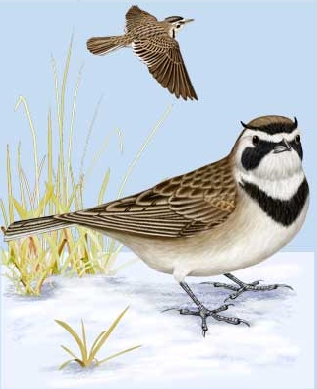|

Medium-sized
lark with pale or dark brown upperparts and white underparts.
Face and throat are pale yellow to white and mask, cap, and ear tufts
are black. Tail is dark with white edges.
Forages on ground, usually in open fields. Eats seeds, grains, insects
and small mollusks.

|
HORNED
LARK
Eremophila alpestris
PASSERIFORMES
Larks (Alaudidae)
Range and Habitat
Breeds in Alaska and Canadian Arctic, coastal Canada, and south throughout
all of the U.S. except southeast. Spends winters from southern Canada
southward; also found in Eurasia. Preferred habitats include plains,
fields, airports, and beaches.
SOUNDS: "pit-wit,wee-pit,pit-wee", "tsee-tete",
"zeet"
The Horned Lark is the only member of the lark family that is native
to the new world. They are early nesters with nests found in February
even in the northern states.
These birds return to their birthplace after every migration (a characteristic
known as philopatric). Because of this, local populations have adapted
to the color of their habitat resulting in 15 distinct subspecies in
the West.
A group of larks has many collective nouns, including an "ascension",
"chattering", "exaltation", "happiness",
and "springul" of larks.
The Horned Lark has a large range, estimated globally at 10,000,000
kilometers. Native to The Americas, Europe, and Asia, this bird prefers
shrubland, grassland, and marine ecosystems. The global population of
this bird is estimated at 140,000,000 individuals and does not show
signs of decline that would necessitate inclusion on the IUCN Red List.
For this reason, the current evaluation status of the Horned Lark is
Least Concern.
|